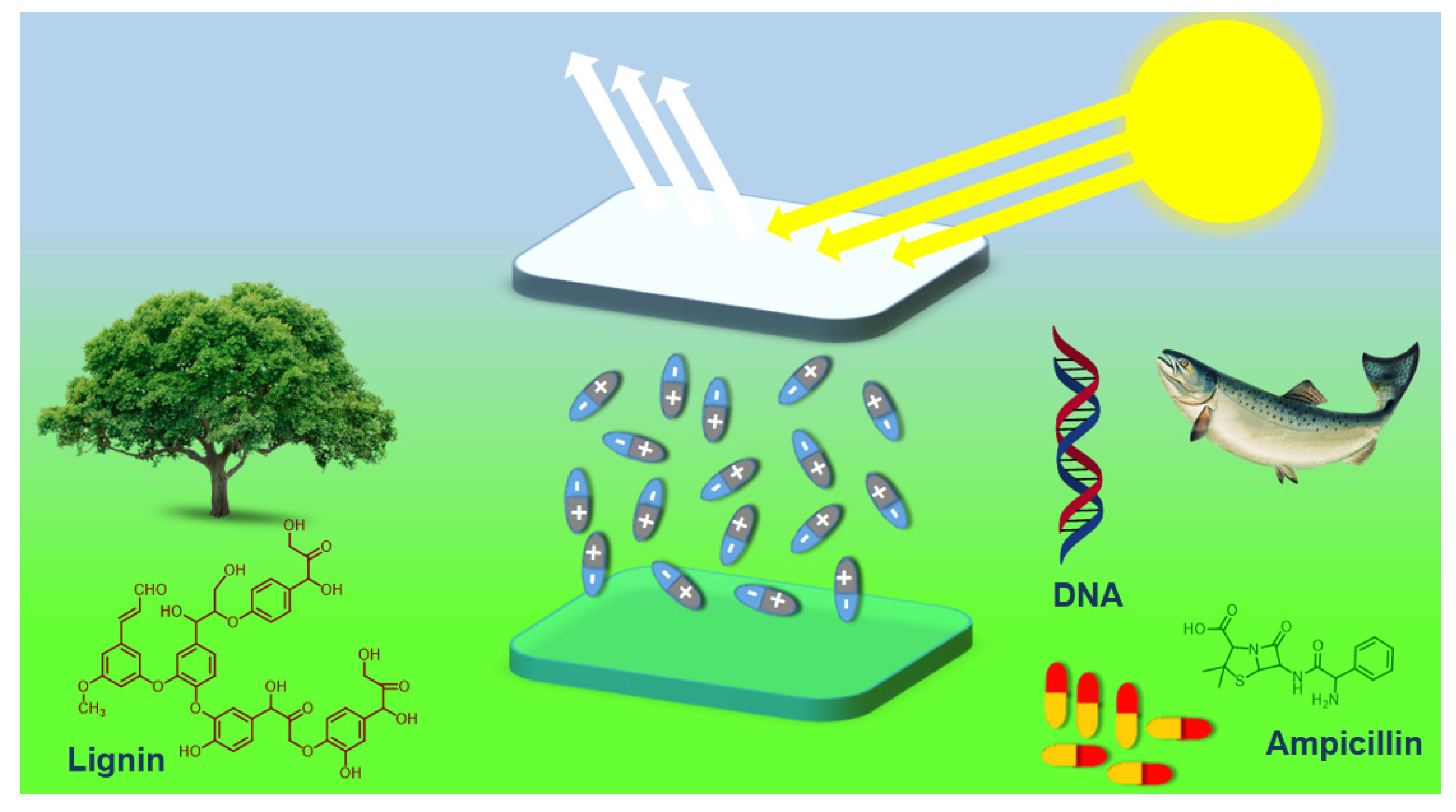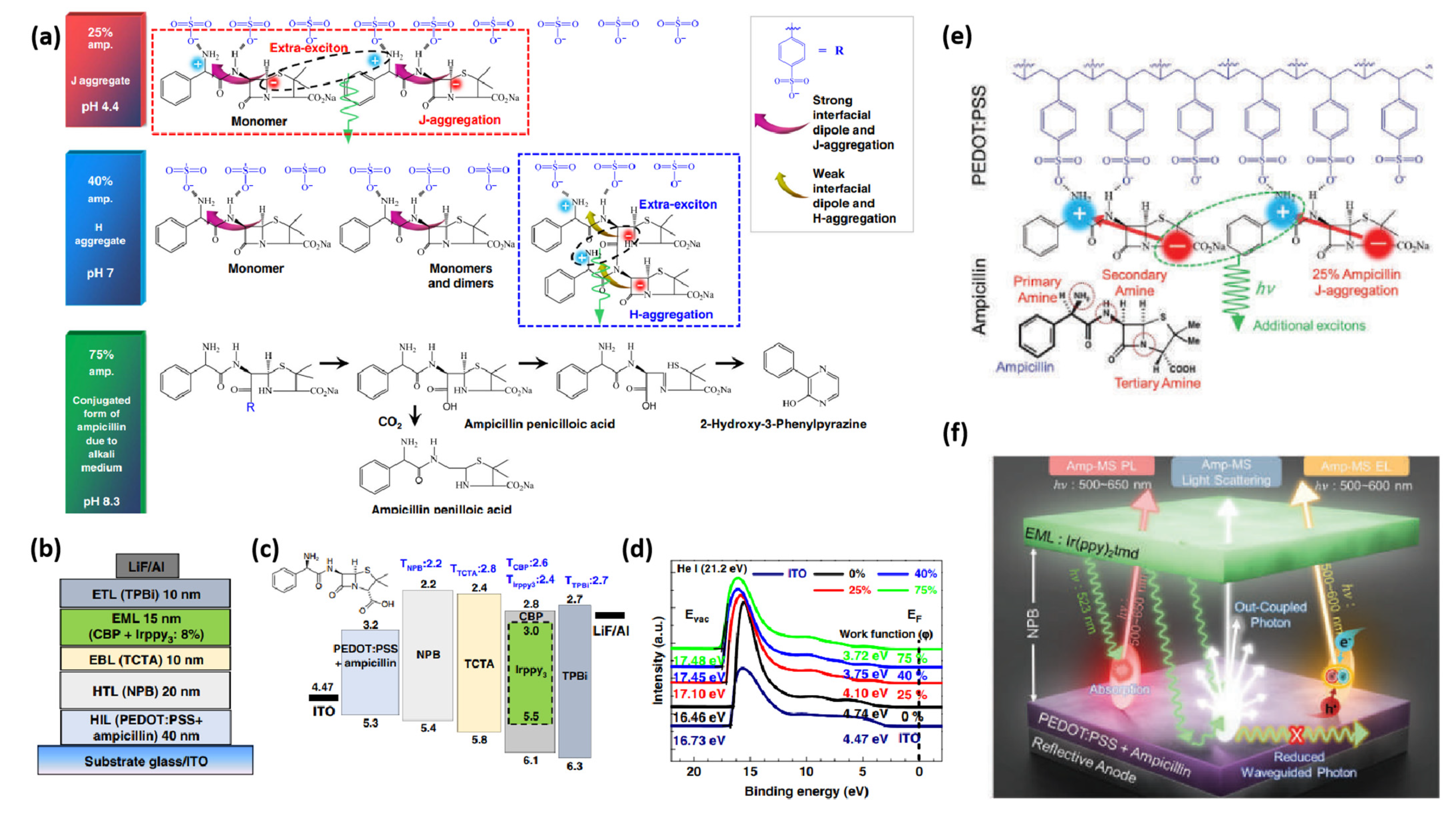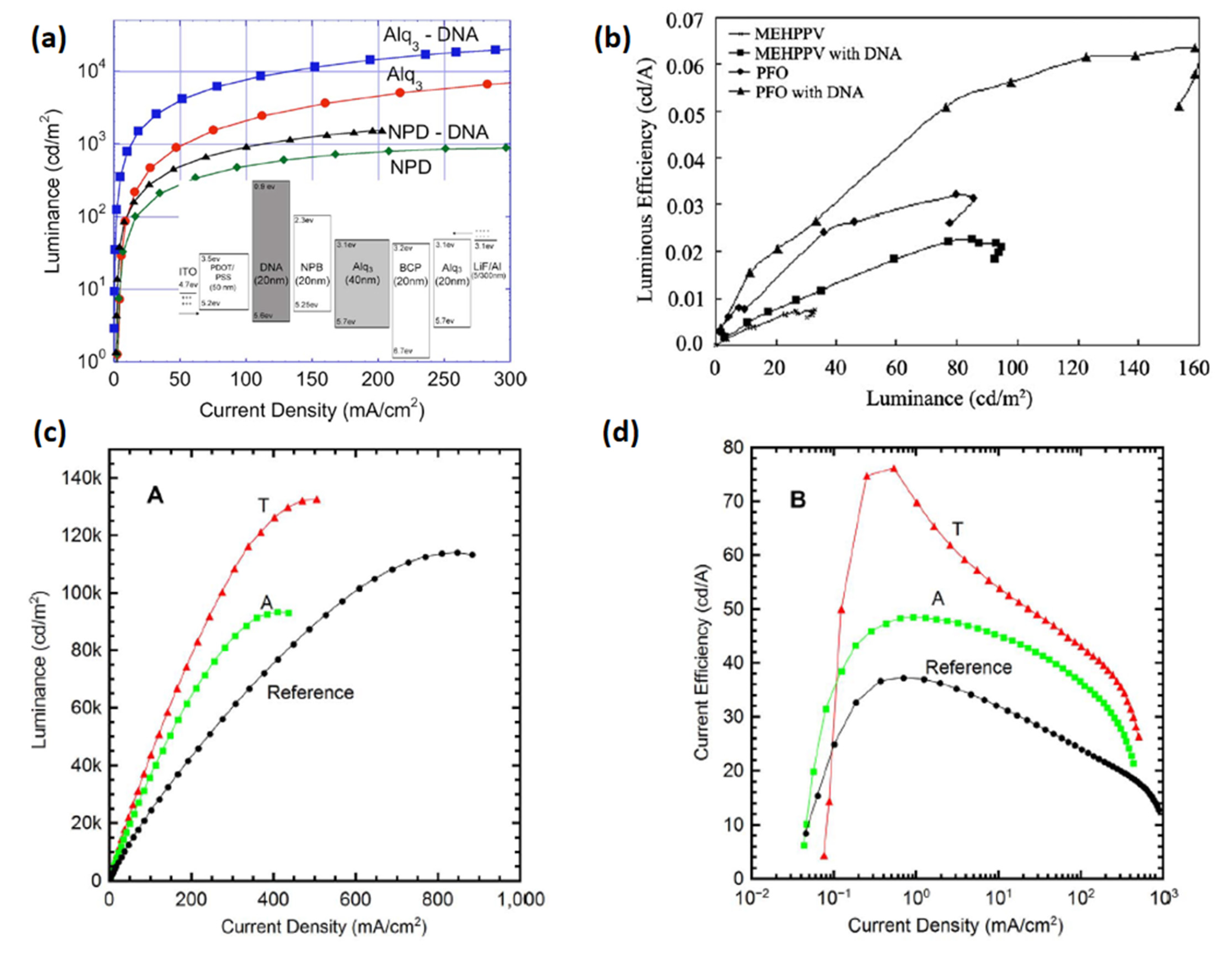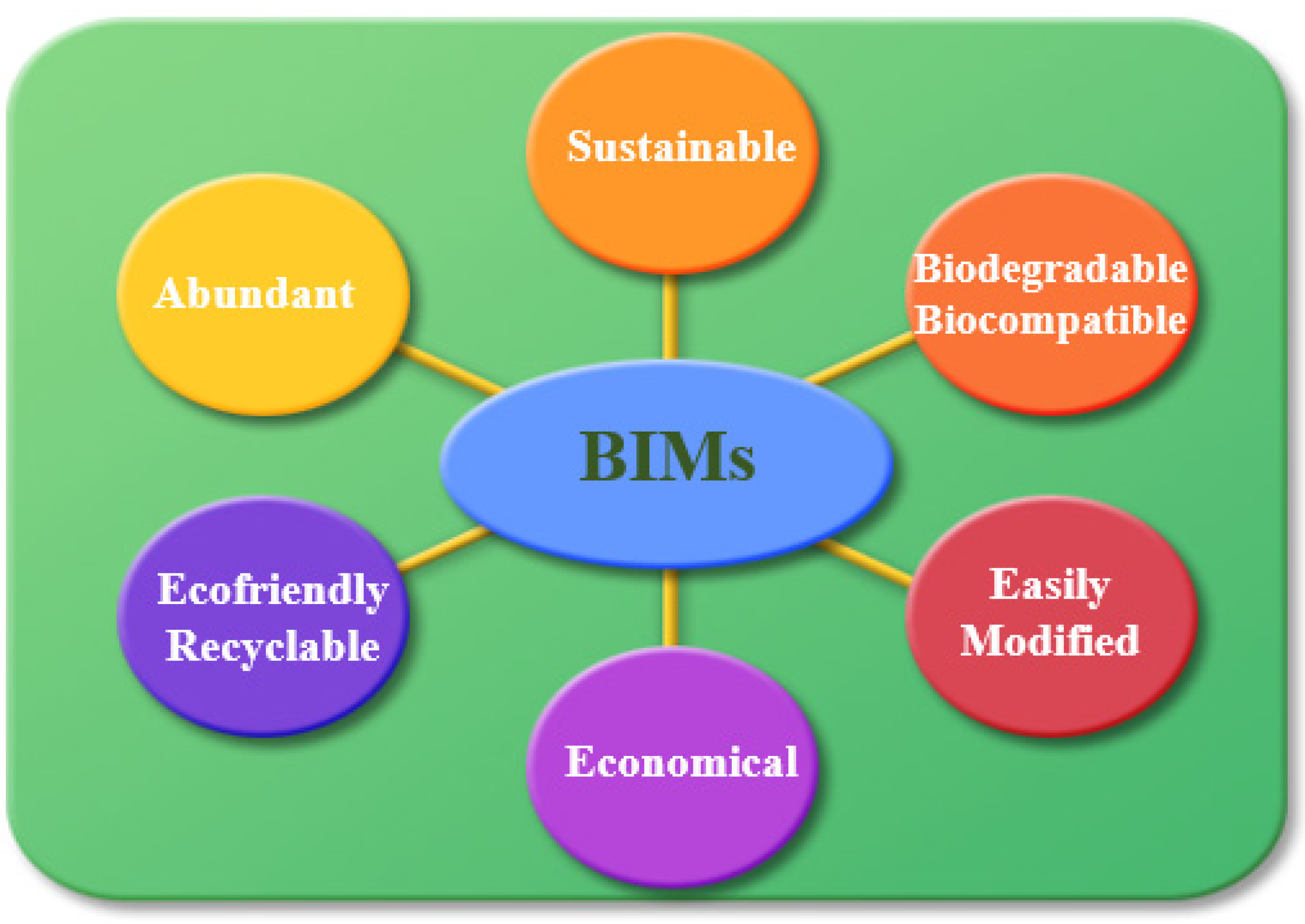Biological Interfacial Materials for Organic Light-Emitting Diodes
Abstract
1. Introduction
2. Biological Materials
2.1. Ampicillin
2.2. Lignin and Lignosulfonates
2.3. Deoxyribonucleic Acid (DNA)
2.4. Nucleobases (NBs)
3. Working Mechanism of OLEDs and Significance of Biological Interfacial Materials
3.1. Working Mechanism of OLEDs
3.2. Significance of Biological Interfacial Materials
4. State-of-the-Art and Recent Progress in BIM-Based OLED Devices
4.1. Ampicillin
4.2. DNA
4.3. Nucleobases (NBs)
4.4. Sulphonated Lignin (SL)
5. Advantages of BIMs
6. Conclusions and Outlook
Author Contributions
Funding
Acknowledgments
Conflicts of Interest
References
- Riede, M.; Spoltore, D.; Leo, K. Organic solar cells—The path to commercial success. Adv. Energy Mater. 2020, 11, 2002653. [Google Scholar] [CrossRef]
- Song, J.; Lee, H.; Jeong, E.G.; Choi, K.C.; Yoo, S. Organic light-emitting diodes: Pushing toward the limits and beyond. Adv. Mater. 2020, 32, e1907539. [Google Scholar] [CrossRef]
- Wang, J.; Liu, K.; Ma, L.; Zhan, X. Triarylamine: Versatile platform for organic, dye-sensitized, and perovskite solar cells. Chemical reviews. Chem. Rev. 2016, 116, 14675–14725. [Google Scholar] [CrossRef]
- Ye, L.; Zhang, S.; Huo, L.; Zhang, M.; Hou, J. Molecular design toward highly efficient photovoltaic polymers based on two-dimensional conjugated benzodithiophene. Accounts of chemical research. Acc. Chem. Res. 2014, 47, 1595–1603. [Google Scholar] [CrossRef]
- Yan, C.; Barlow, S.; Wang, Z.; Yan, H.; Jen, A.K.Y.; Marder, S.R.; Zhan, X. Non-fullerene acceptors for organic solar cells. Nature Reviews Materials. Nat. Rev. Mater. 2018, 3, 18003. [Google Scholar] [CrossRef]
- Hou, J.; Inganas, O.; Friend, R.H.; Gao, F. Organic solar cells based on non-fullerene acceptors. Nature materials. Nat. Mater. 2018, 17, 119–128. [Google Scholar] [CrossRef] [PubMed]
- Wang, C.; Dong, H.; Jiang, L.; Hu, W. Organic semiconductor crystals. Chem. Soc. Rev. 2018, 47, 422–500. [Google Scholar] [CrossRef] [PubMed]
- Paterson, A.F.; Singh, S.; Fallon, K.J.; Hodsden, T.; Han, Y.; Schroeder, B.C.; Bronstein, H.; Heeney, M.; McCulloch, I.; Anthopoulos, T.D. Recent progress in high-mobility organic transistors: A reality check. Adv. Mater. 2018, 30, e1801079. [Google Scholar] [CrossRef] [PubMed][Green Version]
- Dou, J.H.; Zheng, Y.Q.; Yao, Z.F.; Lei, T.; Shen, X.; Luo, X.Y.; Yu, Z.A.; Zhang, S.D.; Han, G.; Wang, Z.; et al. A Cofacially Stacked Electron-Deficient Small Molecule with a High Electron Mobility of over 10 cm2 V−1 s−1 in Air. Adv. Mater. 2015, 27, 8051–8055. [Google Scholar] [CrossRef]
- Jou, J.H.; Kumar, S.; Agrawal, A.; Li, T.H.; Sahoo, S. Approaches for fabricating high efficiency organic light emitting diodes. J. Mater. Chem. C 2015, 3, 2974–3002. [Google Scholar] [CrossRef]
- Yang, Z.; Mao, Z.; Xie, Z.; Zhang, Y.; Liu, S.; Zhao, J.; Xu, J.; Chi, Z.; Aldred, M.P. Recent advances in organic thermally activated delayed fluorescence materials. Chem. Soc. Rev. 2017, 46, 915–1016. [Google Scholar] [CrossRef]
- Meng, L.; Zhang, Y.; Wan, X.; Li, C.; Zhang, X.; Wang, Y.; Ke, X.; Xiao, Z.; Ding, L.; Xia, R.; et al. Organic and solution-processed tandem solar cells with 17.3% efficiency. Science 2018, 361, 1094–1098. [Google Scholar] [CrossRef][Green Version]
- Liu, Y.C.; Li, C.S.; Ren, Z.J.; Yan, S.K.; Bryce, M.R. All-inorganic thermally activated delayed fluorescence materials for organic light-emitting diodes. Nat. Rev. Mater. 2018, 3, 18020. [Google Scholar] [CrossRef]
- Cui, Y.; Yao, H.; Zhang, J.; Zhang, T.; Wang, Y.; Hong, L.; Xian, K.; Xu, B.; Zhang, S.; Peng, J.; et al. Over 16% efficiency organic photovoltaic cells enabled by a chlorinated acceptor with increased open-circuit voltages. Nat. Commun. 2019, 10, 2515. [Google Scholar] [CrossRef] [PubMed][Green Version]
- Nawaz, A.; Kumar, A.; Hümmelgen, I.A. Ultra-high mobility in defect-free poly (3-hexylthiophene-2, 5-diyl) field-effect transistors through supra-molecular alignment. Org. Electron. 2017, 51, 94–102. [Google Scholar] [CrossRef]
- Anthony, J.E. Addressing challenges. Nat. Mater. 2014, 13, 773–775. [Google Scholar] [CrossRef]
- Chueh, C.C.; Li, C.Z.; Jen, A.K.Y. Recent progress and perspective in solution-processed Interfacial materials for efficient and stable polymer and organometal perovskite solar cells. Energy Environ. Sci. 2015, 8, 1160–1189. [Google Scholar] [CrossRef]
- Peng, X.; Hu, L.; Qin, F.; Zhou, Y.H.; Chu, P.K. Low work function surface modifiers for solution processed electronics: A review. Adv. Mater. Interfaces 2018, 5, 1701404. [Google Scholar] [CrossRef]
- Li, T.; Chen, Z.; Wang, Y.; Tu, J.; Deng, X.; Li, Q.; Li, Z. Materials for interfaces in organic solar cells and photodetectors. ACS Appl. Mater. Interfaces 2020, 12, 3301–3326. [Google Scholar] [CrossRef]
- Suemori, K.; Matsumura, Y.; Yokoyama, M.; Hiramoto, M.J. Large area organic solar cells with thick and transparent protection layers. Appl. Phys. 2006, 45, L472. [Google Scholar] [CrossRef]
- Reese, M.O.; Morfa, A.J.; White, M.S.; Kopidakis, N.; Shaheen, S.E.; Rumbles, G.; Ginley, D.S. Pathways for the degradation of organic photovoltaics P3HT:PCBM based devices. Sol. Energy Mater. Sol. Cells 2008, 92, 746–752. [Google Scholar] [CrossRef]
- Cowan, S.R.; Banerji, N.; Leong, W.L.; Heeger, A.J. Charge formation, recombination and sweep-out dynamics in organic solar cells. Adv. Funct. Mater. 2012, 22, 1116–1128. [Google Scholar] [CrossRef][Green Version]
- Li, D.; Lai, W.Y.; Zhang, Y.Z.; Huang, W. Printable transparent conductive films for flexible electronics. Adv. Mater. 2018, 30, 1704738. [Google Scholar] [CrossRef] [PubMed]
- Yin, Z.; Wei, J.; Zheng, Q. Interfacial materials for organic solar cells: Recent advances and perspectives. Adv. Sci. 2016, 3, 1500362. [Google Scholar] [CrossRef] [PubMed][Green Version]
- Zhao, F.; Zhou, J.; He, D.; Wang, C.; Lin, Y. Low-cost materials for organic solar cells. J. Mater. Chem. C 2021, 9, 15395–15406. [Google Scholar] [CrossRef]
- Nie, R.; Li, A.; Deng, X. Environmentally friendly biomaterials as an interfacial layer for highly efficient and stable inverted organic solar cells. J. Mater. Chem. A 2014, 2, 6734–6739. [Google Scholar] [CrossRef]
- Pham, H.D.; Xianqiang, L.; Li, W.; Manzhos, S.; Kyaw, A.K.K.; Sonar, P. Organic interfacial materials for perovskite optoelectronic devices. Energ. Environ. Sci. 2019, 12, 1177–1209. [Google Scholar] [CrossRef]
- Gallezot, P. Conversion of biomass to selected chemical products. Chem. Soc. Rev. 2012, 41, 1538–1558. [Google Scholar] [CrossRef] [PubMed]
- Irimia-Vladu, M.; Głowacki, E.D.; Voss, G.; Bauer, S.; Sariciftci, N.S. Green and biodegradeable electronics. Mater. Today 2012, 15, 340–346. [Google Scholar] [CrossRef]
- Li, J.; Wang, N.; Wang, Y.; Liang, Z.; Peng, Y.; Yang, C.; Bao, X.; Xia, Y. Efficient inverted organic solar cells with a thin natural biomaterial L-Arginine as electron transport layer. Solar Energy 2020, 196, 168–176. [Google Scholar] [CrossRef]
- Wu, Y.; Wang, J.; Qiu, X.; Yang, R.; Lou, H.; Bao, X.; Li, Y. Highly efficient inverted perovskite solar cells with sulphonated lignin doped PEDOT as hole extract layer. ACS Appl. Mater. Interfaces 2016, 8, 12377–12383. [Google Scholar] [CrossRef] [PubMed]
- Gomez, E.F.; Venkatraman, V.; Grote, J.G.; Steckl, A.J. Exploring the potential of nucleic acid bases in organic light emitting diodes. Adv. Mater. 2015, 27, 7552–7562. [Google Scholar] [CrossRef] [PubMed]
- Li, C.; Zhao, X.; Wang, A.; Huber, G.W.; Zhang, T. Catalytic transformation of lignin for the production of chemicals and fuels. Chem. Rev. 2015, 115, 11559–11624. [Google Scholar] [CrossRef]
- Alonso, D.M.; Wettstein, S.G.; Dumesic, J.A. Bimettalic catalysts for the upgrading of biomass to fuels and chemicals. Chem. Soc. Rev. 2012, 41, 8075–8098. [Google Scholar] [CrossRef] [PubMed]
- Tan, X.F.; Liu, S.B.; Liu, Y.G.; Gu, Y.L.; Zeng, G.M.; Hu, X.J.; Wang, X.; Liu, S.H.; Jiang, L.H. Biochar as potential sustainable precursors for activated carbon production: Multiple applications in in environmental protection and energy storage. Bioresour. Technol. 2017, 227, 359–372. [Google Scholar] [CrossRef]
- Yu, F.; Li, S.; Chen, W.; Wu, T.; Peng, C. Biomass-derived materials for electrochemical energy storage and conversion: Overview and perspectives. Energy Environ. Mater. 2019, 2, 55–67. [Google Scholar] [CrossRef][Green Version]
- Li, J.; Wang, X.; Wang, H.; Wang, S.; Hayat, T.; Alsaedi, A.; Wang, X. Functionalization of biomass carbonaceous aerogels and their application as electrode materials for electr-enhanced recovery of metal-ions. Environ. Sci. Nano 2017, 4, 1114–1123. [Google Scholar] [CrossRef]
- Yang, Q.; Shi, Y.; Fang, Y.; Dong, Y.; Ni, Q.; Zhu, Y.; Fu, Y. Construction of polyaniline aligned on magnetic functionalized biomass carbon giving excellent microwave absorption properties. Compos. Sci. Technol. 2019, 174, 176–183. [Google Scholar] [CrossRef]
- Zhu, H.; Luo, W.; Ciesielski, P.N.; Fang, Z.; Zhu, J.Y.; Henriksson, G.; Himmel, M.E.; Hu, L. Wood-derived materials for green electronics, biological devices and energy applications. Chem. Rev. 2016, 116, 9305–9374. [Google Scholar] [CrossRef]
- Jiang, F.; Li, T.; Li, Y.; Zhang, Y.; Gong, A.; Dai, J.; Hitz, E.; Luo, W.; Hu, L. Wood-based nanotechnologies toward sustainability. Adv. Mater. 2018, 30, 1703453. [Google Scholar] [CrossRef]
- Tadepalli, S.; Slocik, J.M.; Gupta, M.K.; Naik, R.R.; Singamaneni, S. Bio-optics and bio-inspired optical materials. Chem. Rev. 2017, 117, 12705–12763. [Google Scholar] [CrossRef]
- Bajwa, D.S.; Pourhashem, G.; Ullah, A.H.; Bajwa, S.G. A concise review of current lignin production, applications, products and their environmental impact. Industrial Crops and Products. Ind. Crops Prod. 2019, 139, 111526. [Google Scholar] [CrossRef]
- Gillet, M.A.S.; Petitjean, L.; Morais, A.R.C.; da Costa Lopes, A.M.; Łukasik, R.M.; Anastas, P.T. Lignin transformations for high value applications: Towards targeted modifications using green chemistry. Green Chem. 2017, 19, 4200–4233. [Google Scholar] [CrossRef]
- Glasser, W.G. About making lignin great again: Some lessons from the past. Front. Chem. 2019, 7, 565. [Google Scholar] [CrossRef][Green Version]
- Travers, A.; Muskhelishvili, G. DNA structure and function. FEBS J. 2015, 282, 2279–2295. [Google Scholar] [CrossRef]
- Steckl, A.J. DNA: A new material for photonics. Nat. Photonics 2007, 1, 3–5. [Google Scholar] [CrossRef]
- Nizioł, J.; Makyła-Juzak, K.; Marzec, M.M.; Ekiert, R.; Marzec, M.; Gondek, E. Thermal stability of the solid DNA as a novel optical materials. Opt. Mater. 2017, 66, 344–350. [Google Scholar] [CrossRef]
- Muskovich, M.; Bettinger, C.J. Biomaterial-based electronics: Polymers and interfaces in biology and medicine. Adv. Healthc. Mater. 2012, 1, 248–266. [Google Scholar] [CrossRef][Green Version]
- Irimia-Vladu, M.; Sariciftci, N.S.; Bauer, S. Exotic materials for bio-organic electronics. J. Mater. Chem. 2011, 21, 1350–1361. [Google Scholar] [CrossRef]
- Hagen, J.A.; Li, W.; Steckl, A.J.; Grote, J.G. Enhanced emission efficiency in organic light-emitting diodes using deoxyribonucleic acid complex as an electron blocking layer. Appl. Phys. Lett. 2006, 88, 171109. [Google Scholar] [CrossRef][Green Version]
- Zalar, P.; Kamkar, D.; Naik, R.; Ouchen, F.; Grote, J.G.; Bazan, G.C.; Nguyen, T.Q. DNA electron injection interlayers for polymer light-emitting diodes. J. Am. Chem. Soc. 2011, 133, 11010–11013. [Google Scholar] [CrossRef] [PubMed]
- Wei, Q.; Fei, N.N.; Islam, A.; Lei, T.; Hong, L.; Peng, R.X.; Fan, X.; Chen, L.; Gao, P.Q.; Ge, Z.Y. Small-molecule emitters with high quantum efficiency: Mechanisms, structures, and applications in OLED devices. Adv. Opt. Mater. 2018, 6, 1800512. [Google Scholar] [CrossRef]
- Hung, L.S.; Chen, C.H. Recent progress of molecular organic electroluminescent materials. Mater. Sci. Eng. R Rep. 2002, 39, 143–222. [Google Scholar] [CrossRef]
- Islam, A.; Li, J.G.; Pervaiz, M.; Lu, Z.H.; Sain, M.; Chen, L.H.; Ouyang, X.H. Zwitterions for organic/perovskite solar cells, light-emitting devices and lithium ion batteries: Recent progress and perspectives. Adv. Energy Mater. 2019, 9, 1803354. [Google Scholar] [CrossRef]
- Kugler, T.; Logdlund, M.; Salaneck, W.R. Polymer surfaces and interfaces in light-emitting devices. IEEE J. Sel. Top. Quantum Electron. 1998, 4, 14–23. [Google Scholar] [CrossRef]
- Johansson, N.; Cacialli, F.; Xing, K.Z.; Beamson, G.; Clark, D.T.; Friend, R.H.; Salaneck, W.R. A study of ITO-on-PPV interface using photoelectron spectroscopy. Synth. Met. 1998, 92, 207–211. [Google Scholar] [CrossRef]
- Scott, J.C.; Kaufman, J.H.; Brock, P.J.; DiPietro, R.; Salem, J.; Goitia, J.A. Degradation and failure of MEH-PPV light-emitting diodes. J. Appl. Phys. 1996, 79, 2745–2751. [Google Scholar] [CrossRef]
- Schlatmann, A.R.; Floet, D.W.; Hilberer, A.; Garten, F.; Smulders, P.J.M.; Klapwijk, T.M.; Hadziioannou, G. Indium contamination from the indium-tin-oxide electrode in polymer light-emitting diodes. Appl. Phys. Lett. 1996, 69, 1764–1766. [Google Scholar] [CrossRef][Green Version]
- Malliaras, G.G.; Scott, J.C. The roles of injection and mobility in organic light emitting diodes. J. Appl. Phys. 1998, 83, 5399–5403. [Google Scholar] [CrossRef]
- Ho, P.K.; Kim, J.S.; Burroughes, J.H.; Becker, H.; Li, S.F.; Brown, T.M.; Cacialli, F.; Friend, R.H. Molecular-scale interface engineering for polymer light-emitting diodes. Nature 2000, 404, 481–484. [Google Scholar] [CrossRef]
- Yang, X.; Müller, D.C.; Neher, D.; Meerholz, K. Highly efficient polymer electrophosphorescent diodes. Adv. Mater. 2006, 18, 948–954. [Google Scholar] [CrossRef]
- Gomez, E.F.; Venkatraman, V.; Grote, J.G.; Steckl, A.J. DNA bases thymine and adenine in bio-organic light emitting diodes. Sci. Rep. 2014, 4, 7105. [Google Scholar] [CrossRef][Green Version]
- Gomez, E.F.; Steckl, A.J. Improved performance of OLEDs on cellulose epoxy substrate using adenine as a hole injection layer. ACS Photonics 2015, 2, 439–445. [Google Scholar] [CrossRef]
- Li, Y.; Wu, Y.; Zeng, W.; Li, Y.; Xu, L.; Qiu, X.; Chen, R.; Huang, W. Improving efficiency of blue organic light emitting diode with sulphobutylated lignin doped PEDOT as anode layer. ACS Sustain. Chem. Eng. 2016, 4, 2004–2011. [Google Scholar] [CrossRef]
- Hafeez, H.; Jesuraj, P.J.; Kim, D.H.; Lee, J.C.; Shin, J.Y.; Rhee, S.H.; Lee, W.H.; Choi, D.K.; Cha, J.H.; Lee, C.M.; et al. The effect of introducing antibiotics into organic light-emitting diodes. Commun. Phys. 2019, 2, 130. [Google Scholar] [CrossRef][Green Version]
- Robinson-Fuentes, V.A.; Jefferies, T.M.; Branch, S.K. Degradation pathways of ampicillin in alkaline solutions. J. Pharm. Pharmacol. 1997, 49, 843–851. [Google Scholar] [CrossRef]
- Madhwal, D.; Rait, S.S.; Verma, A.; Kumar, A.; Bhatnagar, P.K.; Mathur, P.C.; Onoda, M.J. Increased luminance of MEH-PPV and PFO based PLED using salmon DNA as an electron blocking layer. J. Lumin. 2010, 130, 331–333. [Google Scholar] [CrossRef]
- Kim, D.H.; Lee, C.M.; Islam, A.; Choi, D.H.; Jeong, G.W.; Kim, T.W.; Cho, H.W.; Kim, Y.B.; Shah, S.H.U.; Park, M.J.; et al. Efficient photons extraction in top-emission organic light-emitting diodes using ampicillin microstructures. Adv. Mater. 2022, 34, e2202866. [Google Scholar] [CrossRef]
- Sun, Q.; Chang, D.W.; Dai, L.; Grote, J.; Naik, R. Multilayer white polymer light-emitting diodes with deoxyribonucleic acid-cetyltrimetylammonium complex as a hole-transporting/electron-blocking layer. Appl. Phys. Lett. 2008, 92, 251108. [Google Scholar] [CrossRef][Green Version]
- Sun, Q.; Subramanyam, G.; Dai, L.; Check, M.; Campbell, A.; Naik, R.; Grote, J.; Wang, Y. Highly efficient quantum-dot light-emitting diodes with DNA-CTMA as a combined hole transport and electron blocking layer. ACS Nano 2009, 3, 737–743. [Google Scholar] [CrossRef]
- Hong, N.; Xiao, J.; Li, Y.; Li, Y.; Wu, Y.; Yu, W.; Qiu, X.; Chen, R.; Yip, H.-L.; Huang, W.; et al. Unexpected fluorescence emission of graft sulphonated-acetone-formaldehyde lignin and its application as a dopant of PEDOT for high performance photovoltaic and light-emitting devices. J. Mater. Chem. C 2016, 4, 5297–5306. [Google Scholar] [CrossRef]
- Ali, W.J.A.; Choi, Y.; Jeon, E.; Chae, H. Enhanced charge balance with antibiotics in both electron and hole transport layers of InP/ZnSexS1-x/ZnS-based quantum dot light emitting diodes. J. Alloys Compd. 2022, 900, 16449. [Google Scholar] [CrossRef]
- Kobayashi, S.U.N.; Kusabuka, K.; Nakahira, T.; Takahashi, H. An organic red-emitting diodes with a water soluble DNA-polyaniline complex containing Ru(bpy)32+. J. Mater. Chem. 2001, 11, 1766–1768. [Google Scholar] [CrossRef]
- Koyama, T.; Kawabe, Y.; Ogata, N. Electrolumenescence as a probe for electrical and optical properties of deoxyribonucleic acid. Proc. SPIE 2002, 4464, 248–255. [Google Scholar] [CrossRef]
- Wang, L.L.; Yoshida, J.; Ogata, N. Self assembled supramolecular films derived from marine deoxyribonucleic acid (DNA)-cationic surfactant complexes: Large scale preparation, optical and thermal properties. Chem. Mater. 2001, 13, 1273–1281. [Google Scholar] [CrossRef]
- Nakamura, K.; Ishikawa, T.; Nishioka, D.; Ushikubo, T.; Kobayashi, N. Color-tunable multilayer organic light emitting diode composed of DNA complex and tris (8-hydroxyquinolinato) aluminum. Appl. Phys. Lett. 2010, 97, 235. [Google Scholar] [CrossRef]
- Lee, J.H.P.J.; Lee, Y.T.; Jeon, P.J.; Lee, H.S.; Nam, S.H.; Yi, Y.; Lee, Y.; Im, S. DNA base guanine as hydrogen getter and charge trappin layer embedded in oxide dielectrics for inorganic and organic field effect transistors. ACS Appl. Mater. Interfaces 2014, 6, 4965–4973. [Google Scholar] [CrossRef]
- Mihai Irimia-Vladu, P.A.T.; Reisinger, M.; Shmygleva, L.; Kanbur, Y.; Schwabegger, G.; Bodea, M.; Schwödiauer, R.; Mumyatov, A.; Fergus, J.W.; Razumov, V.F.; et al. Biocompatible and biodegradeable materials for organic field effect transistors. Adv. Funct. Mater. 2010, 20, 4069–4076. [Google Scholar] [CrossRef]
- Giuseppe Maruccio, P.V.; Arima, V.; D’Amico, S.; Biasco, A.; D’Amone, E.; Cingolani, R.; Rinaldi, R.; Masiero, S.; Giorgi, T.; Gottarelli, G. Field effect transistor based on a modified DNA base. Nano Lett. 2003, 3, 479–483. [Google Scholar] [CrossRef]
- Li, Y.; Hong, N.J. An efficient hole transport material based on PEDOT dispersed with ligosulphonate: Preparation, characterization and application in polymer solar cells. J. Mater. Chem. A 2015, 3, 21537–21544. [Google Scholar]
- Lee, C.M.; Lee, W.H.; Jeong, G.W.; Kim, D.H.; Choi, D.H.; Kim, T.W.; Islam, A.; Jesuraj, P.J.; Hafeez, H.; Chae, H.J.; et al. Analysis of device performance and thin film properties of thermally damaged organic light-emitting diodes. Org. Electron. 2021, 99, 106304. [Google Scholar] [CrossRef]
- Islam, A.; Usman, K.; Haider, Z.; Alam, M.F.; Nawaz, A.; Sonar, P. Biomass-derived materials for interface engineering in organic/perovskite photovoltaic and light-emitting devices. Adv. Mater. Technol. 2023, 8, 2201390. [Google Scholar] [CrossRef]







| Device Structure | Interfacial Layer | Function | CE (cd A−1) | PE (lm W−1) | EQE (%) | Ref. |
|---|---|---|---|---|---|---|
| ITO/PEDOT:PSS/DNA–CTMA/NPB/Alq3/BCP | DNA–CTMA | Electron blocking layer | 8.2 | - | - | [50] |
| ITO/PEDOT:PSS/DNA–CTMA/PFO:MEH-PPV/Cs2CO3/Al | DNA–CTMA | Hole transport and electron blocking layer | 10.0 | - | - | [69] |
| ITO/PEDOT:PSS/poly-TPD:PVK/DNA–CTMA/QDs/TPBi/Alq3/Al | DNA–CTMA | Hole transport and electron blocking layer | 4.0 | - | - | [70] |
| ITO/PEDOT:PSS/MEH-PPV/DNA/Al | DNA | Electron transport layer | 0.15 | - | - | [51] |
| ITO/PEDOT:PSS/Adenine/NPB/CBP:Ir(ppy)3/BCP/Alq3/LiF/Al | Adenine | Hole transport and electron blocking layer | 48 | - | - | [62] |
| ITO/PEDOT:PSS/Thymine/NPB/CBP:Ir(ppy)3/BCP/Alq3/LiF/Al | Thymine | Hole transport and electron blocking layer | 76 | - | - | [62] |
| ITO/PEDOT:PSS/Adenine/CBP:Ir(ppy)3/BCP/Alq3/LiF/Al | Adenine | Hole/electron blocking layer | 51.8 | 21.2 | 14.3 | [32] |
| Cellulose/Au/adenine/NPB/CBP:Ir(ppy)3/BCP/Alq3/LiF/Al | Adenine | Hole injection layer | 31.7 | - | - | [63] |
| ITO/PEDOT:ASLS/TAPC/ mCP/mCP:FIrpic/TmPyPb/LiF/Al | Alkyl-Sulfonated Lignin | Hole transportation | 37.65 | 12.84 | - | [64] |
| ITO/PEDOT:GSL/TAPC/mCP/mCP:Flrpic/TmPyPb/LiF/Al | Grafted-Sulfonated Lignin | Hole transportation | 26.56 | 14.67 | - | [71] |
| ITO/Ampicillin-PEDOT:PSS/NPB/TCTA/CBP:Ir(ppy)3/TPBi/LiF/Al | Ampicillin (25%) | Hole transportation | 120 | 70 | 35 | [65] |
| ITO-APC-ITO/Ampicillin-PEDOT:PSS/NPB/TCTA/CBP:Ir(ppy)2tmd/TPBi/LiF/Mg:Ag | Ampicillin (25%) | Hole transportation | 270 | 185 | 68 | [68] |
| ITO/Ampicillin-PEDOT:PSS/TFB/InP-QDs/Ampicillin-ZnO/Al | Ampicillin (25%) | Hole and electron transportation | 6.3 | 6.6 | 4.7 | [72] |
Disclaimer/Publisher’s Note: The statements, opinions and data contained in all publications are solely those of the individual author(s) and contributor(s) and not of MDPI and/or the editor(s). MDPI and/or the editor(s) disclaim responsibility for any injury to people or property resulting from any ideas, methods, instructions or products referred to in the content. |
© 2023 by the authors. Licensee MDPI, Basel, Switzerland. This article is an open access article distributed under the terms and conditions of the Creative Commons Attribution (CC BY) license (https://creativecommons.org/licenses/by/4.0/).
Share and Cite
Islam, A.; Shah, S.H.U.; Haider, Z.; Imran, M.; Amin, A.; Haider, S.K.; Li, M.-D. Biological Interfacial Materials for Organic Light-Emitting Diodes. Micromachines 2023, 14, 1171. https://doi.org/10.3390/mi14061171
Islam A, Shah SHU, Haider Z, Imran M, Amin A, Haider SK, Li M-D. Biological Interfacial Materials for Organic Light-Emitting Diodes. Micromachines. 2023; 14(6):1171. https://doi.org/10.3390/mi14061171
Chicago/Turabian StyleIslam, Amjad, Syed Hamad Ullah Shah, Zeeshan Haider, Muhammad Imran, Al Amin, Syed Kamran Haider, and Ming-De Li. 2023. "Biological Interfacial Materials for Organic Light-Emitting Diodes" Micromachines 14, no. 6: 1171. https://doi.org/10.3390/mi14061171
APA StyleIslam, A., Shah, S. H. U., Haider, Z., Imran, M., Amin, A., Haider, S. K., & Li, M.-D. (2023). Biological Interfacial Materials for Organic Light-Emitting Diodes. Micromachines, 14(6), 1171. https://doi.org/10.3390/mi14061171






